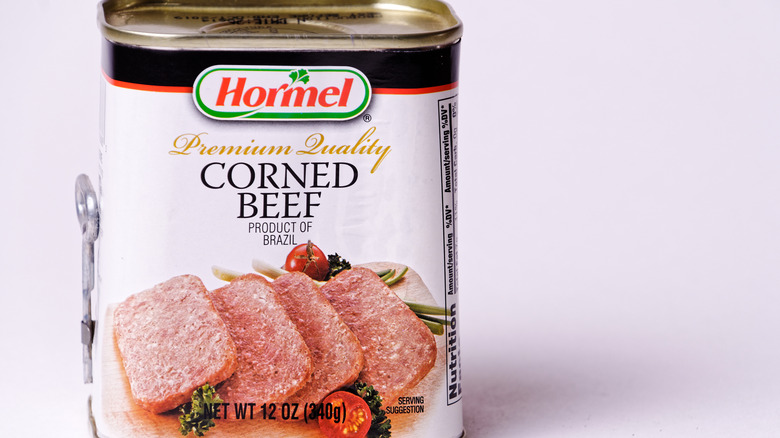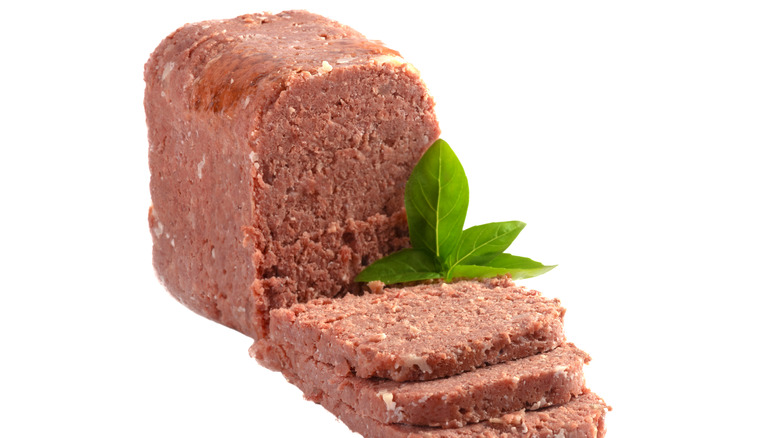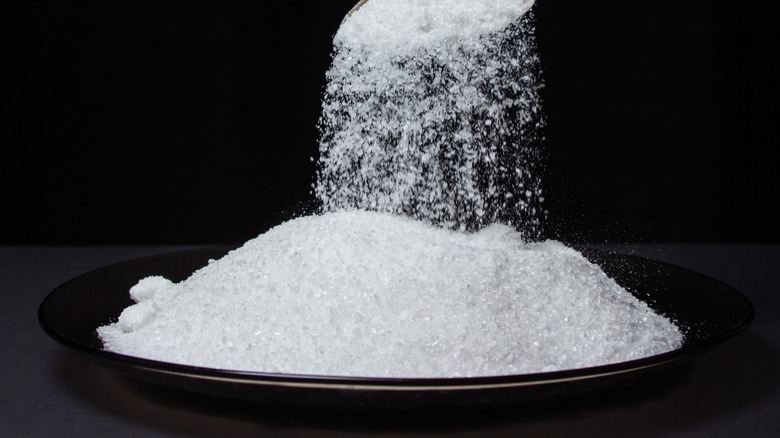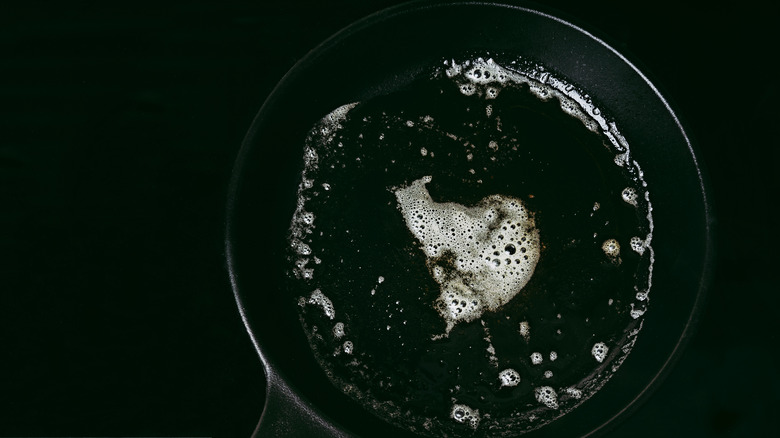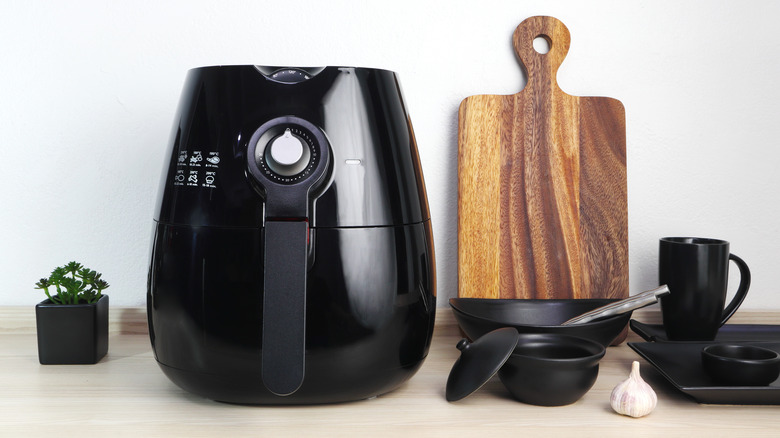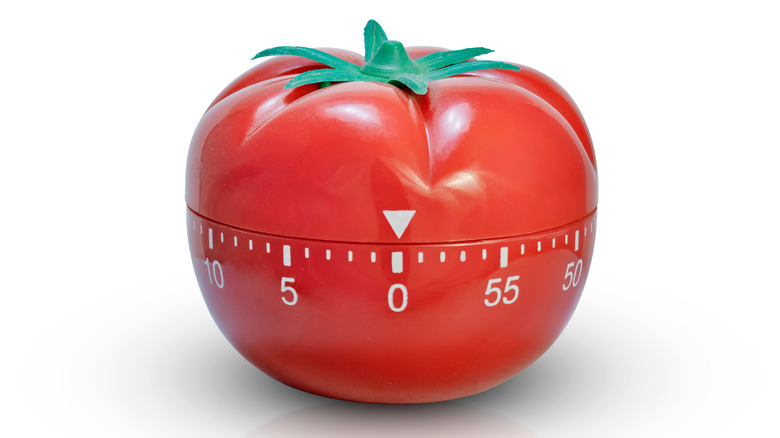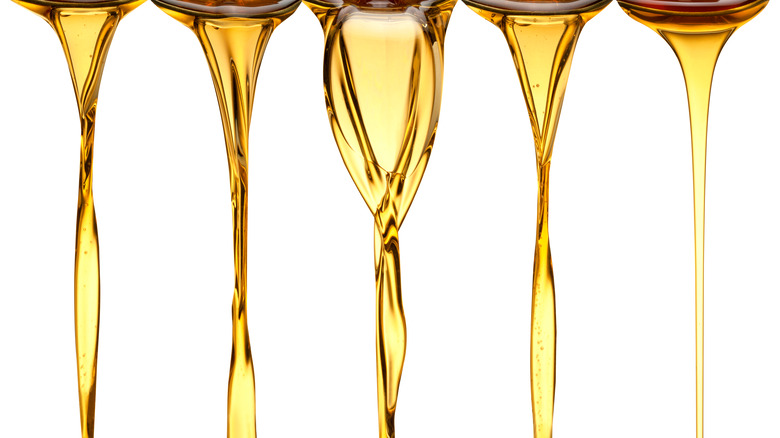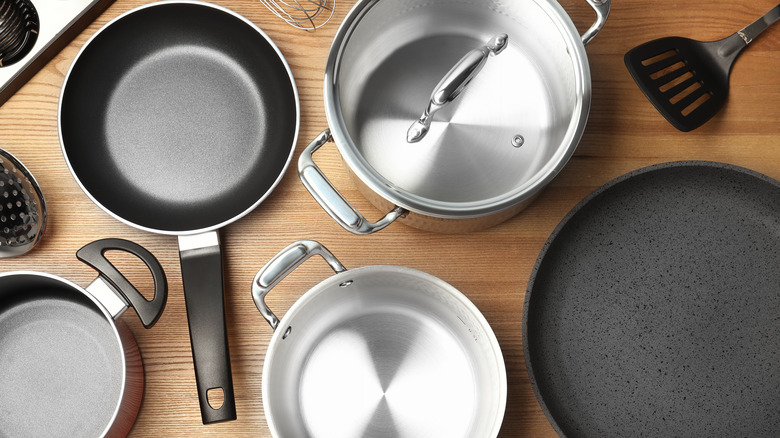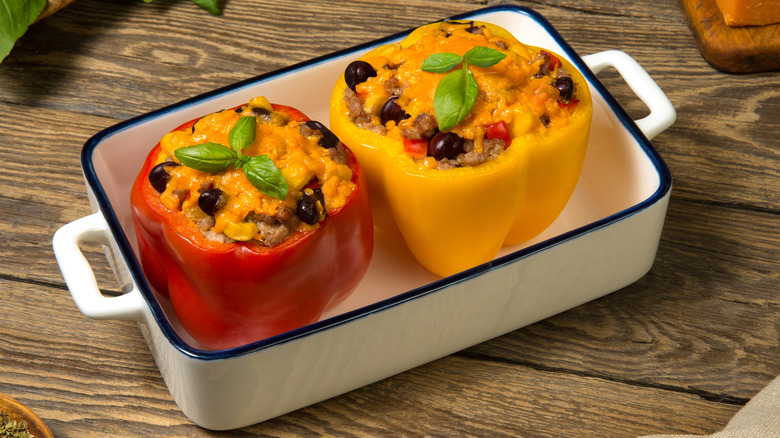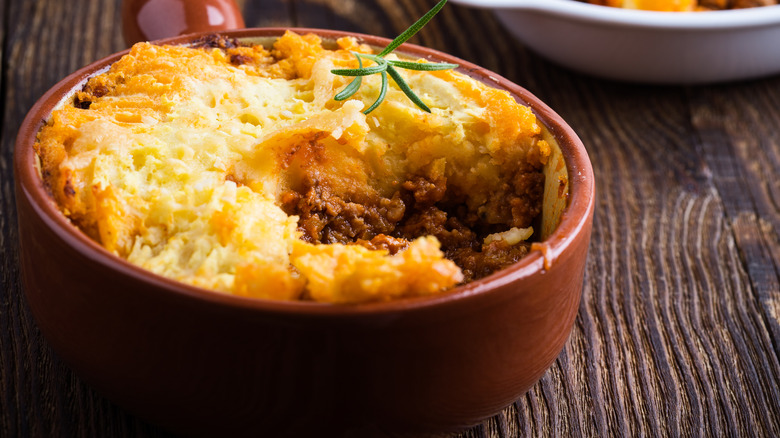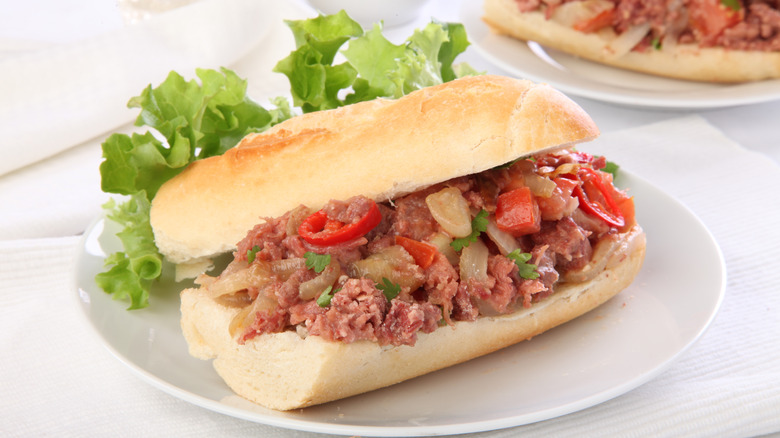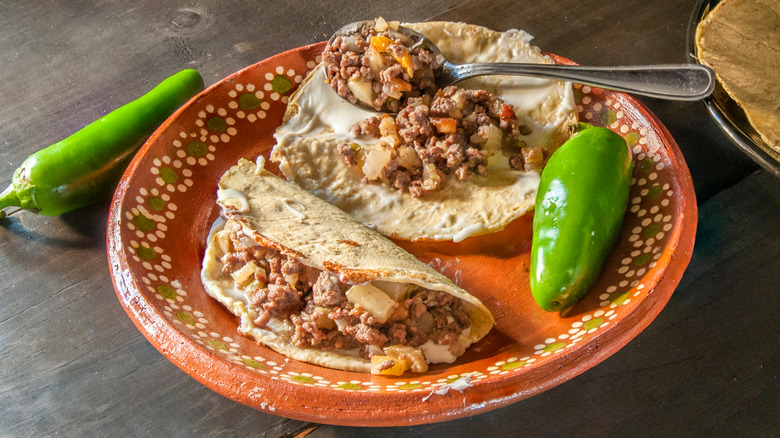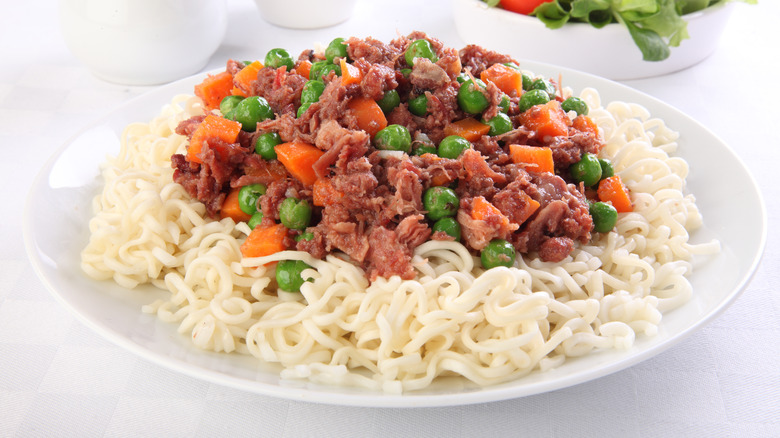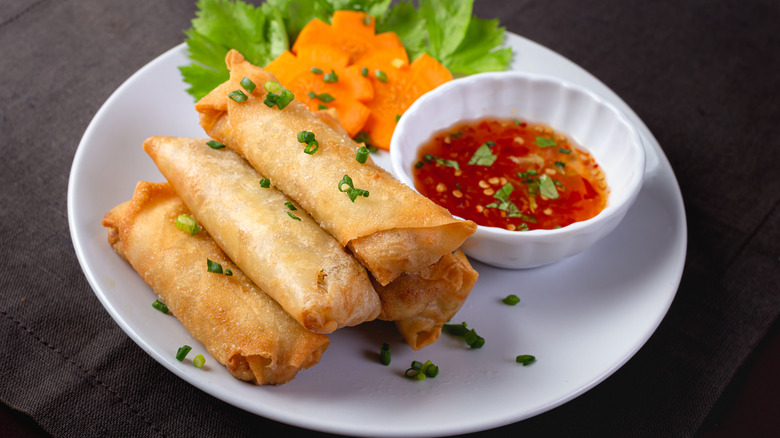Mistakes Everyone Makes With Canned Corned Beef And Corned Beef Hash
We may receive a commission on purchases made from links.
Correction 7/28/22: An earlier version of this article listed Hormel corned beef hash as containing 870 grams of sodium. It has been updated to 870 milligrams.
While corned beef can (arguably) go down as one of the most delectable holiday-related dishes in America, its canned cousin probably takes the cake as one of the most questionable foods known in American food history. (It most likely shares a spot with its cousin, SPAM.)
But this hearty canned meat kind of gets a bad rap, and that's probably because most of us have only been exposed to it when roughing it in the outdoors. Canned corned beef is generally one of those essential "camping experience" foods, where you crack it open (using a camping can opener, which is an experience in itself), dump it into a skillet, and let it cook (we mean burn) before "enjoying" it around an open flame. And that's where the experience usually stops. (Unless you're a college student and need something to zhoozh up your instant ramen.)
But it's time to rethink this canned meat because chances are, you're doing it wrong. Canned corned beef can be quite tasty ... when done properly. Just make sure to keep on reading, so you can avoid the most common mistakes that pretty much everyone makes when cooking canned corned beef.
You're eating it as-is
Canned corned beef is great as is ... but if you really want to kick it up a notch, toss in some fresh ingredients. If you've never had the pleasure of opening a can of this less-than-visually-appetizing meat, just a friendly heads-up: it's going to be dense, yet mushy, and the color will be a bit dull. It's not the most appetizing thing to look at.
But you can make it into the most amazing, flavorful, and colorful dish by simply adding a few staple ingredients. The first (and most obvious) addition would be to just put an egg on it. A fried egg makes pretty much anything better. Relive St. Patrick's Day and add some diced, sautéed cabbage, or pan fry potatoes, bell peppers, and onions and make a hearty mishmash of hash n' Potatoes O' Brien (via Food).
If you're feeling like "less is more," then just chop up some fresh herbs. While The Guardian says to steer clear from herbs like flat leaf parsley (don't feel obligated to listen to that), try adding some fresh chives or scallions, or even chopping tossing in fresh dill or cilantro ... unless cilantro reminds you of soap. Then don't do that to yourself.
You're not soaking it to remove excess salt
It would be a great understatement to say that canned corned beef hash isn't high on the NaCl list. According to the supermarket chain HEB, one serving of Hormel's canned corned beef hash (7.5 ounces, or 213 grams) contains 870 mg of sodium! (That's about 36% of your recommended daily intake, in case you needed more numbers to chew on.) Lucky for you, there's an incredibly easy workaround, so you won't be chugging down water to help dilute your meal (and also to prevent meal-induced dehydration).
While the following technique is meant for whole pieces of corned beef, the same principle can be applied to the canned version, as well (via Price of Meat). First, empty your can of hash into a bowl and add cold water. Make sure that you loosen the canned corned beef with a spatula or fork so that the water can penetrate into each meaty fiber, and then put the bowl in your refrigerator for an hour or so. Rinse and repeat the process a couple of times. Afterward, give the sodium-reduced hash some time to dry out before tossing it in a pan with hot oil. (Because water and oil in a hot pan don't mix.)
While this won't remove all of the tasty yet controversial white mineral, it'll definitely dumb it down a bit. If this seems like a time-consuming process, well, good things come to those who wait.
And you're not rendering off the fat
"But how can you render the fat off of canned meat?" you might be wondering? We're so glad you asked. This is the easiest, though most efficient, way to remove the excess fat from your hash. Because let's face it — canned corned beef is not only high in sodium, it also shouldn't be your first (or second, or third) choice when it comes to a low-fat or low cholesterol meal (via HEB).
Rendering off the fat from canned meats requires a bit of patience, but it's worth it. De Kook Tips says to boil the can of corned beef hash, and then using the proper kitchen safety items (like oven mitts), set the can down on a non-slippery surface — heat-resistant silicone mats work great. Open the can and pour out the fat that has now magically floated to the top. Voilà! Your canned corned beef hash has now been rendered.
An important note: dispose of the rendered fat in an aluminum can or heat-proof vessel and let it cool before tossing it. Do not pour it down the drain — unless you want to call a plumber — because once the rendered fat cools down, it turns back to a solid (yay science)!
You're not using an air fryer
If you've rendered as much of the fat from your canned corned beef as possible, but are still worried about adding fat to get your meaty breakfast of champions super crispy, then we'd like to invite you to meet your new best friend: the air fryer. These ingenious little tabletop contraptions were invented for those who not only enjoy convenience but are also constantly looking at their smartwatch because the food is just taking too long to cook. (We see you. We get it.) The air fryer can fry up foods in a fraction of their normal cook time. What's even better is that to attain the perfect level of crisp, these gizmos don't need any added fats or oils. If this sounds like sorcery, don't worry. It's not. (Though, air fryers are pretty mystical. All they need is a unicorn.)
To make crispy canned corned beef hash, Hormel states that all you need to do is spray the fryer basket with non-stick spray, add your canned corned beef hash, and cook it at 370 F for 15 to 20 minutes. (Here's the fun part.) Make three or four indentations in the canned corned beef and carefully break an egg into each little hash dent. Let the entire thing go for another four to five minutes and check out the tasty breakfast you just created. (We bet it tastes like magic.)
You're not cooking it long enough
Canned corned beef hash is one of those dishes that seems to take absolutely forever to crisp up. And once it does, it quickly turns from crisp to burnt. (It's like avocados — they're green one day and mushy the next.) According to the blog Half Scratched, there is a method to the crisping madness, which is to cook the hash on both sides, but only long enough so that some of the meaty moisture is cooked off. It seems simple enough, but that still doesn't do anything for the waiting game. (Because let's face it. When you're waiting for something to cook, it's like watching paint dry ... or water boil.)
While cook times vary — it depends on the type of cookware you're using, as well as the temperature and amount of hash being prepared — this can be as short a process as six to eight minutes on each side, or up to 25 minutes (for you ultra-crisp lovers out there, writes Summer Yule). So no matter what, you're going to have to suck it up and wait for your breakfast deliciousness. (Unfortunately, even an air fryer won't magically make time speed up for you.)
And you're probably using the wrong oil
Butter is not always better, and not all oils are created equal, said some chef somewhere, at some point in history. (Or maybe it was Benjamin Franklin? Who knows.) That being said, some food blogs, like Summer Yule, note that because canned corned beef hash is already well-equipped with its own built-in cooking grease, extra oil isn't really necessary to give it that extra crisp factor.
But should you choose to use oil to add that little bit of something — whether it be crisp assurance or flavor — the best type to use would be an oil with a higher burning point. The burning point, also called the smoking point (via Masterclass), just means that these oils won't start to burn (or smoke) until they reach a designated temperature. So when it comes to crisping up your canned corned beef breakfast bonanza, you're going to want to stick to oils like vegetable or canola, because they can reach a temperature of 400 F to 450 F before they begin to smoke. Butter will burn, and has the lowest smoking point at 302 F. If you're looking for a healthier oil, refined coconut oil has a burning point of 450 F, refined or light olive oil starts burning at 465 F, and refined avocado oil can reach up to 520 F before it will threaten to sound off your smoke alarm.
You might be cooking at the wrong temperature
When it comes to your starting temperature, make sure that your canned corned beef hash hasn't come straight out of the fridge (via Substitute Cooking). This is a product that not only needs to be mixed thoroughly upon opening, but it also needs to be evenly spread out in your cooking pan to make sure that everything gets cooked evenly. The Spicy Apron says you should max it out at ½ inch thick. Cold canned corned beef hash will be harder to mix, spread, and will be more trouble than it's worth (because no one likes semi-crispy and partially soggy hash).
The next important step is to preheat your pan on medium — not low, not high, just right. Don't stray from the temperature path on this one. A low flame will result in slow cooking (this is where the cooking term low and slow does not apply), which means no crisping up and a mushy meal. Cooking at a high temperature could spell disaster, especially if you're using oil. A high flame means your oil can quickly burn, which means your hash will probably get stuck to the pan (or catch on fire).
Just remember that the medium heat setting is there for a reason — it's the middle way all the way. No more, no less.
Or using the wrong pan
Right off the bat, refrain from using stainless steel to cook your hash. Stainless steel cookware is great, but it doesn't work for all types of food or methods of cookery. The Science of Cooking explains that stainless steel pans work well with sauces, caramelization, tomatoes, and wine. However, the same does not apply to most other foods, especially protein-based foods like meat and eggs. This is because chemical bonds are formed between metal atoms and protein particles, which means your breakfast and your stainless steel pan will end up in an embrace that even the mighty vinegar will have a tough time breaking up.
Now that you know what not to use, the recommended pan for cooking optimally crispy, crunchy, delectable canned corned beef hash would be a seasoned cast iron skillet. If you don't have one of these hefty pans in your kitchen arsenal, your next best bet would be a Teflon pan (also known as a nonstick pan). Either works well, so go forth and fry on.
You're not getting creative
You may think that canned corned beef is basically just reserved for breakfast, but that's not the case. All you need is a little imagination. Sometimes a kitchen that needs to be restocked is the best instigator for working with what you've got. (It makes you feel like you're on an episode of Food Network's "Chopped," too!)
If you're going to a St. Patty's Day celebration — or any type of party, for that matter — The Boat Galley has a recipe for a rich and creamy no-cook chip dip that utilizes canned corned beef, sour cream (or mayonnaise ... or both), and Worcestershire sauce. You can also make a casserole with this canned breakfast meat by mixing it with cream of celery soup, potatoes, and a few other kitchen staples, and baking it at 375 F (via Ice Cream Inspiration). Canned corned beef hash can also be used to make a super tasty stew, according to one Redditor. All you need to do is add canned crushed tomatoes, sautéed carrots and onions, and some chopped cabbage, and let it simmer on low for a few minutes. Maybe serve it with some cornbread or on a bed of rice. But it's also probably hearty enough on its own.
And you're not delving into different foodie cultures
Like some other prominent shelf-stable foods — think of can-tastic cousin Spam or even the condiment king ketchup (which has roots in Asian cuisine, by the way) — canned corned beef has also made a name for itself in other foodie cultures.
Taste Atlas notes that in the Philippines, a famous breakfast dish called Cornsilog is typically eaten for breakfast. It consists of three components: fried eggs, garlic fried rice, and corned beef. (Canned corned beef is also used when homemade corned beef isn't readily available.) The name Cornsilog is actually a blending of each of the individual dishes combined: corn (corned beef), si (siligog rice — garlic fried rice), and log (itlog — fried eggs). This hearty breakfast can sometimes be served with a few slices of tomatoes. (You know, for the health factor.)
In Jamaica, canned corned beef is known as bully beef, according to the food blog Eat With Your Eyes. It really rose in popularity in the late 1980s after Hurricane Gilbert — the most devastating and destructive storm in Jamaica's history (via Hurricane Science) pretty much obliterated the island. Fresh produce and meat were scarce, if not impossible, to procure. But canned foods, well, they were plentiful. This both loved and reviled dish traditionally consists of canned corned beef, bell peppers, onion, garlic, black pepper, thyme, and scotch bonnet peppers. It's frequently served with rice, boiled unripened bananas, or fried dumplings (or anything boiled and starchy, like potatoes or yams).
You're not using it on a sandwich
Canned corned beef shouldn't be limited to just a fork and knife (or spork) dish. This meal in a can retains its cylindrical shape quite well, thanks to the both natural and artificial binding ingredients involved. It only makes sens that canned corned beef would make a rather suitable sandwich filling. After all, if you strip it all down to the basics, it's just mostly shredded beef and potatoes. (Mostly.)
A Reuben sandwich uses sliced corned beef as its main ingredient, along with marbled rye bread, sauerkraut, Swiss cheese, Thousand Island dressing, and butter. Canned corned beef makes a perfect switcheroo if you're short on the real thing, or don't have pastrami readily available. Once everything is assembled, grill it up like a grilled cheese sandwich and enjoy. The sauerkraut also acts as a buffer for the saltiness (a taste hack also mentioned by Price of Meat). If you're not up for a multi-ingredient sammie, why not turn back time and enjoy a good old-fashioned Sloppy Joe. Sub in the canned corned beef for the ground beef, and you've got yourself a quick, tasty, and messy reminder of why napkins were invented.
Or subbing it in as a taco filling
Have you ever met a person who didn't enjoy a good taco or burrito? What about breakfast tacos or burritos? While these two food items typically seem to be divided into Team Taco and Team Burrito, we think it's safe to say that both of them are equally delicious in their own way and both are quite good at doing their job — filling you up with a hearty, flavorful, and satisfying breakfast. (And a reason to take a mid-morning siesta.)
If you look at canned corned beef hash, it's basically screaming to be folded up in a tortilla or taco shell. It's already been confirmed that it's a suitable breakfast food as is, but when partnered up with its eggy BFF, it's formidable. Just because canned corned beef is considered to be a "breakfast food" doesn't mean that you should only reserve it for "first meal of the day" burritos (or tacos), either. Fry it up and serve it with crunchy taco shells, sour cream, pico de gallo, and cilantro or shredded cabbage, and you'll have a very happy tummy. If you're part of Team Burrito, then fry it up with some black beans, finely chopped onion, jalapeño, sour cream, and queso fresco, and you're set. (For a nap.)
You're not turning it into meatballs or adding it to pasta sauces
Meatballs are another universally beloved food that can be found in one round form or another across the globe (via The Atlantic). Everyone loves meatballs. You can add them to soups, they obviously jive with pasta, and they play quite well as a sandwich filler. When making meatballs, it might seem a little strange to use canned corned beef instead of the usual ground chuck, pork, or veal. But it works. (Another pleasant perk about using canned corned beef is that you won't need to add any extra salt — the hash has you covered for that ingredient.) When prepping your little meaty morsels, just substitute the canned corned beef for the meat ingredient. Keep in mind that you may want to cut back on other salty components because of the aforementioned reason. The best part is that because canned corned beef hash is already precooked, you can always taste test your meaty mixture to make sure it's not overwhelmingly salty. Just be sure to taste it before you add the raw egg.
The same process goes along for meat-based pasta sauces, like pasta bolognese. Just swap out the meat components and cut back on the sodium-related ingredients. If your sauce ends up a bit too salty, you can always add a creamy or acidic element to help cut that back. (Remember that bread will always be there to make sure that no sauce will be left behind.)
Or adding it to egg rolls
You may be thinking, "Why?" And we ask, "Why not?" Egg rolls come in all shapes and sizes and have all sorts of different fillings to choose from. They're the perfect finger food for snacks, parties, and late-night munchy cravings when you want something crispy but don't feel like using the stove ... and a hot vat of oil.
You can put pretty much anything in a crispy wonton skin, and it will taste absolutely divine. And we're not just talking bacon and avocado (though that, too, is a match made in heaven.) Cheeseburger fixings, Thanksgiving leftovers, and also a Philly cheesesteak have all been repurposed in the form of an egg roll. So of course, a corned beef hash egg roll — complete with shredded carrots, onions, and cabbage — should also be part of your finger-friendly fried foods repertoire. Make it even better by mixing up a sweet and spicy honey mustard dipping sauce, using grainy mustard instead of the normal deli or yellow kind.
